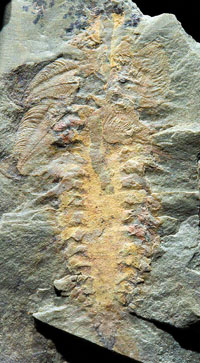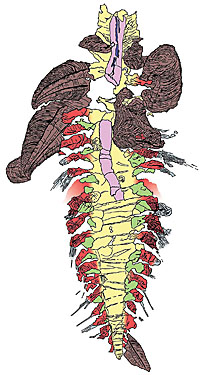 | This newly discovered fossil of an extinct armored machaeridian worm is providing scientists with a more complete picture of the animal's anatomy. |
Discovery of a fossil specimen in southeastern Morocco that preserves evidence
of the animal’s soft tissues has solved a paleontological puzzle about
the origins of an extinct group of bizarre slug-like animals with rows of
mineralized armor plates on their backs, according to a paper in Nature.
— By Janet Rettig Emanuel
T H I S
Fossil solves mystery of
extinct animal's origins
While evolution has produced great diversity in the body designs of animals,
over the course of history several highly distinct groups, such as trilobites
and ammonites, have become extinct. The new fossil is of an unusual creature
known as a machaeridian, an invertebrate (or animal without a backbone) that
existed from 485 to 305 million years ago.
“The new specimen unequivocally identifies machaeridians as annelid worms,
an extremely successful and diverse group of animals that includes familiar living
animals like the sea mouse, the earthworm and the leech,” says ?Jakob Vinther,
a graduate student in the Department of Geology & Geophysics at Yale. The
specimen was found in an area that had earlier been identified as a rich source
of exceptionally preserved fossils including sponges, trilobites, echinoderms
and other less-familiar invertebrates.
First described over 150 years ago, armor plates of these strange animals have
been found in marine fossil deposits worldwide covering the 180 million years
in which they existed, indicating that they were an important component of ancient
seafloor ecosystems. Until now there was little information about their body
design or how they might be related to other ancient — or currently living — animals.
“These animals disintegrated quickly after death, so complete fossils of
their dorsal armor are rare, and their record until now consisted mostly of isolated
armor plates scattered in the sediment,” says Vinther. The dilemma of studying
ancient organisms, he notes, is that the soft body parts, including most internal
organs, are unavailable for study because they usually decompose before they
can become fossilized.

The soft tissues of the machaeridian worm revealed by the fossil: the trunk (yellow), limb (red), bristles (gray), attachment of shell plates (green), gut (purple) and dorsal linear structure (blue).
Previous patchy evidence was insufficient to reveal the relationships of the
machaeridians to other animals, and there was much speculation about their position
in the tree of life. Different authors suggested relationships to groups as varied
as mollusks (clams and snails), barnacles (crustaceans — including shrimps,
crabs and crayfish), echinoderms (starfish and sea urchins) and annelid worms
(aquatic bristle worms and garden earthworms).
The inch-long specimen that was recently discovered shows that, below the dorsal
armor, the machaeridians had an elongate body with paired, soft, limb-like extensions
on each segment, and two bundles of long, stiff bristles on each extension. The
segmented nature of the body, and especially the presence of soft “limbs” carrying
bristles, unequivocally identified the machaeridians as annelid worms, say the
scientists.
According to the authors, although the exact relationship of machaeridians within
the annelid worms is still uncertain, the presence of modified scales suggests
that they may even belong to a group of marine bristle worms that are still in
existence today.
Senior author Derek Briggs, the Frederick William Beinecke Professor of Geology
and Geophysics at Yale, notes: “This exciting discovery has provided important
new insights into annelid evolution, showing that some of these worms, which
first appeared during the Cambrian radiation, evolved a highly distinctive dorsal,
mineralized armor early in their history.
“It also highlights the great importance of the study of exceptional fossil
sites, and of paleobiology in general, for a better understanding of the evolution
of our biosphere,” adds Briggs, who is director of the Yale Institute for
Biospheric Studies and will assume the directorship of the Yale Peabody Museum
of Natural History in July.
The third author of the study is Peter Van Roy at Ghent University (Belgium),
now at University College, Dublin, who first recognized the importance of the
specimen.
 W E E K ' S
W E E K ' S S T O R I E S
S T O R I E S![]()
 Yale cuts costs for families and students
Yale cuts costs for families and students![]()
![]()
 Homebuyer benefit increased
Homebuyer benefit increased![]()
![]()
 Fossil solves mystery of extinct animal's origins
Fossil solves mystery of extinct animal's origins![]()
![]()
 Team learns Abu Dhabi desert once lush habitat
Team learns Abu Dhabi desert once lush habitat![]()
![]()
 Meeting the challenges of nursing care in Nicaragua
Meeting the challenges of nursing care in Nicaragua![]()
![]()
 Foundation’s gift to the School of Drama establishes . . .
Foundation’s gift to the School of Drama establishes . . .![]()
ENDOWED PROFESSORSHIPS
 Marans has been appointed as Harris Professor
Marans has been appointed as Harris Professor![]()
 Medzhitov named first incumbent of Wallace chair
Medzhitov named first incumbent of Wallace chair![]()
 State is designated as Cohen Associate Professor
State is designated as Cohen Associate Professor![]()
![]()
 Study: Despite efforts, racial disparities in cancer care continue
Study: Despite efforts, racial disparities in cancer care continue![]()
![]()
 Law School students argue case before the nation’s highest court
Law School students argue case before the nation’s highest court![]()
![]()
 Sharp cited as ‘superb teacher of teachers’
Sharp cited as ‘superb teacher of teachers’![]()
![]()
 Events commemorate Martin Luther King Jr. Day
Events commemorate Martin Luther King Jr. Day![]()
![]()
 The color printmaking revolution is highlighted in new exhibition
The color printmaking revolution is highlighted in new exhibition![]()
![]()
 Symposium to examine the university’s role as architectural patron
Symposium to examine the university’s role as architectural patron![]()
![]()
 Forum will explore the use of neuroimaging in study of alcoholism
Forum will explore the use of neuroimaging in study of alcoholism![]()
![]()
 Memorial Service for George Hersey
Memorial Service for George Hersey![]()
![]()
 Yale Books in Brief
Yale Books in Brief![]()
![]()
 Campus Notes
Campus Notes![]()
Bulletin Home |
| Visiting on Campus
Visiting on Campus |
| Calendar of Events
Calendar of Events |
| In the News
In the News![]()
Bulletin Board |
| Classified Ads
Classified Ads |
| Search Archives
Search Archives |
| Deadlines
Deadlines![]()
Bulletin Staff |
| Public Affairs
Public Affairs |
| News Releases
News Releases |
| E-Mail Us
E-Mail Us |
| Yale Home
Yale Home